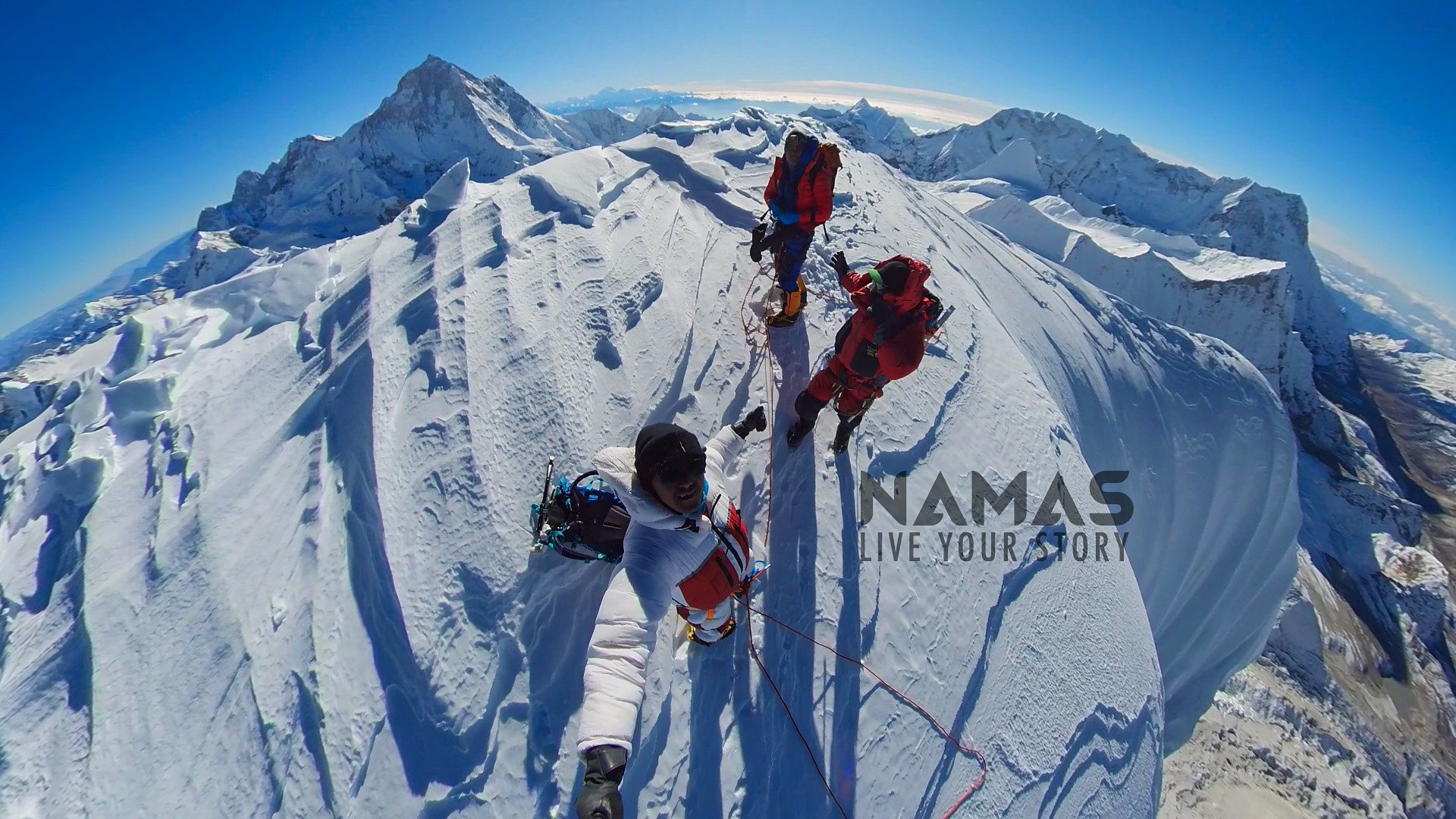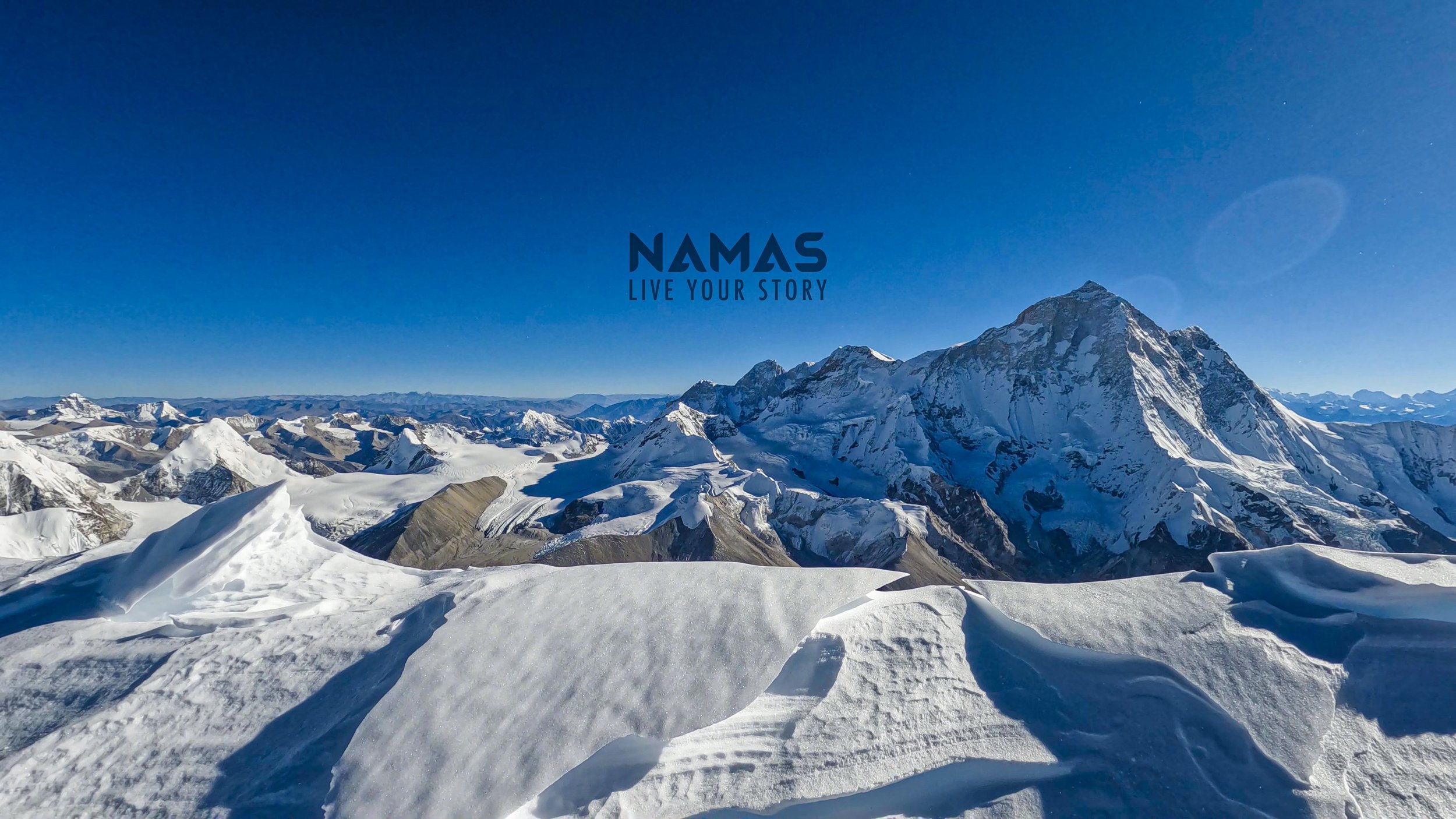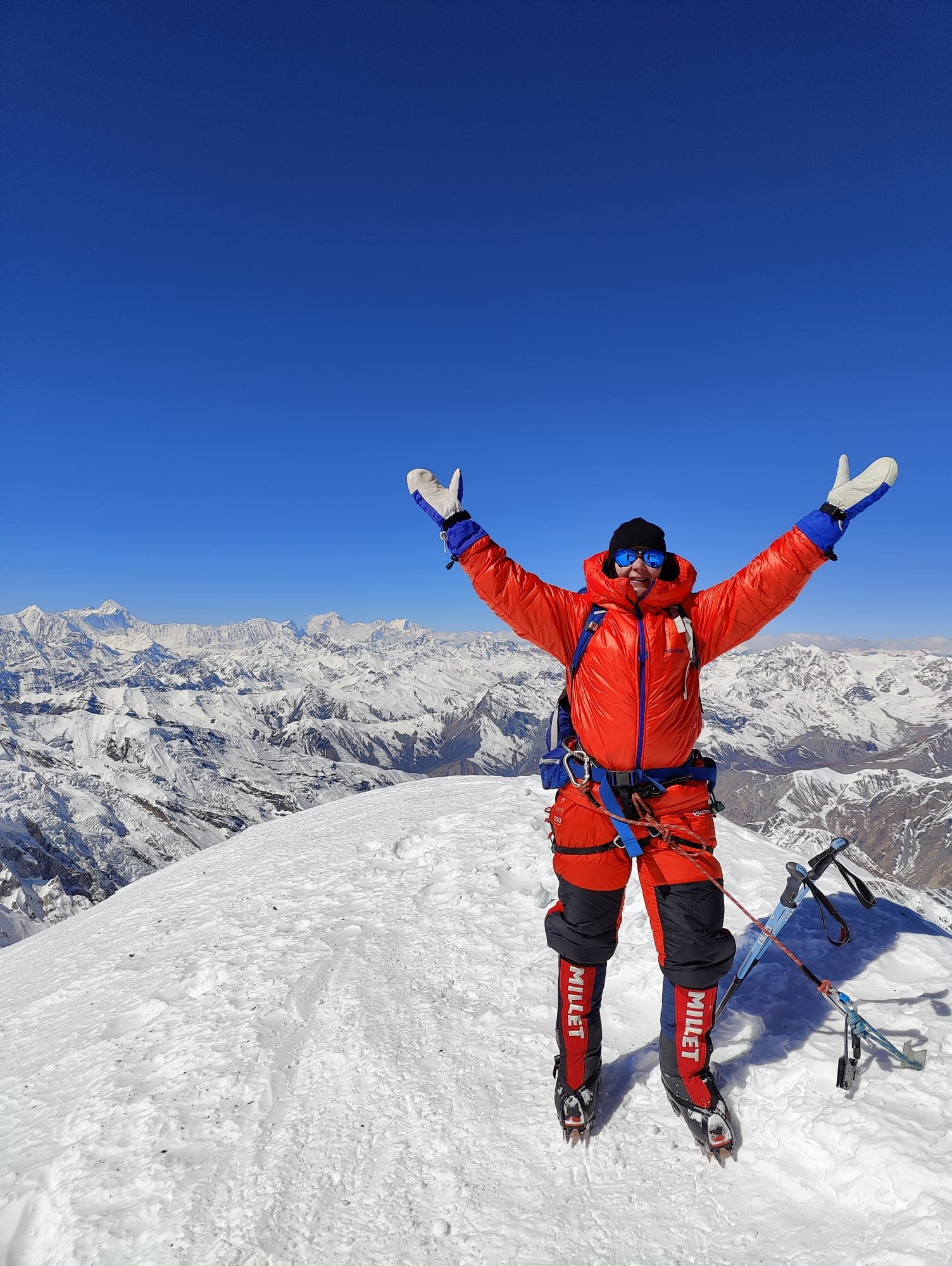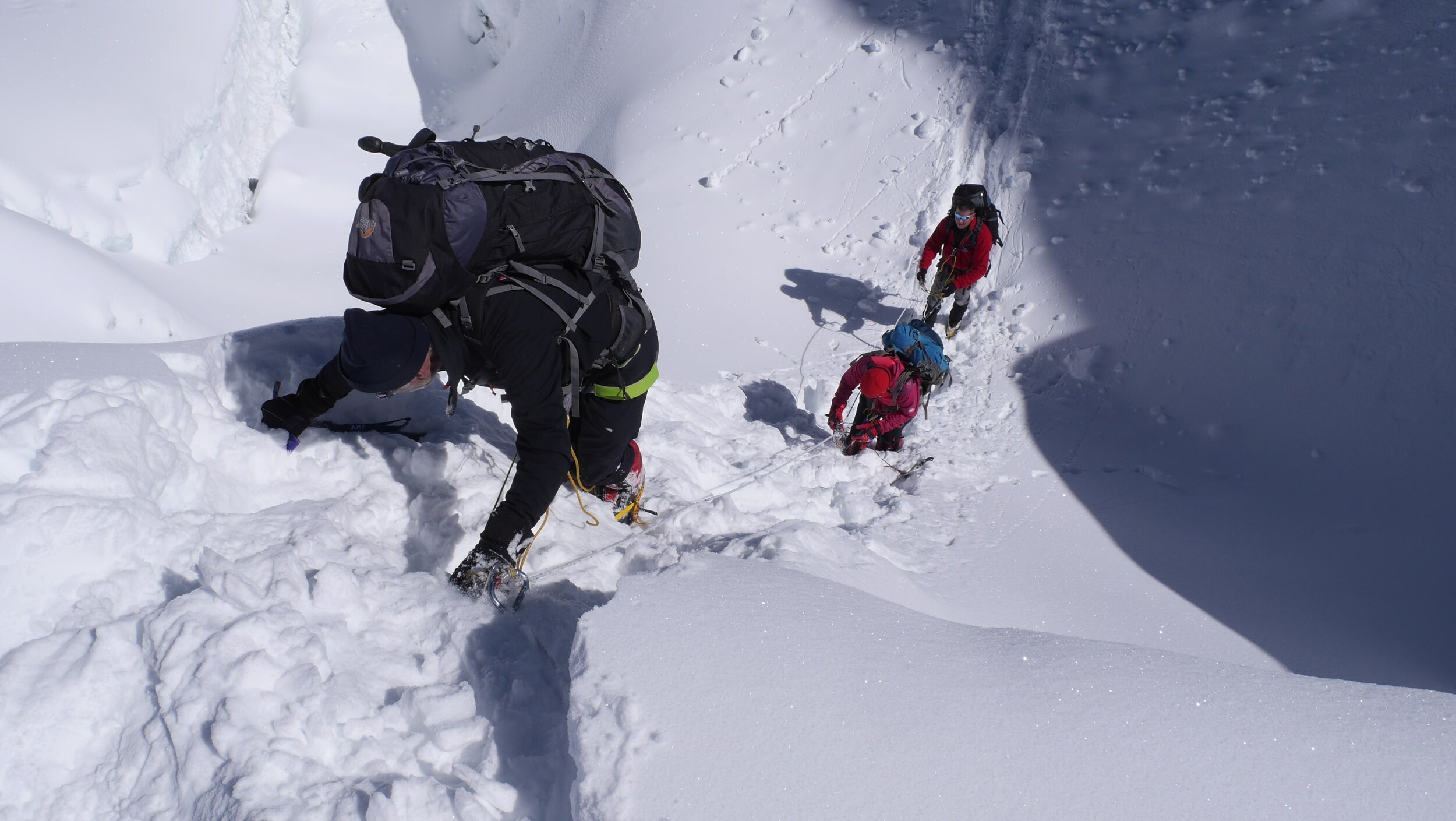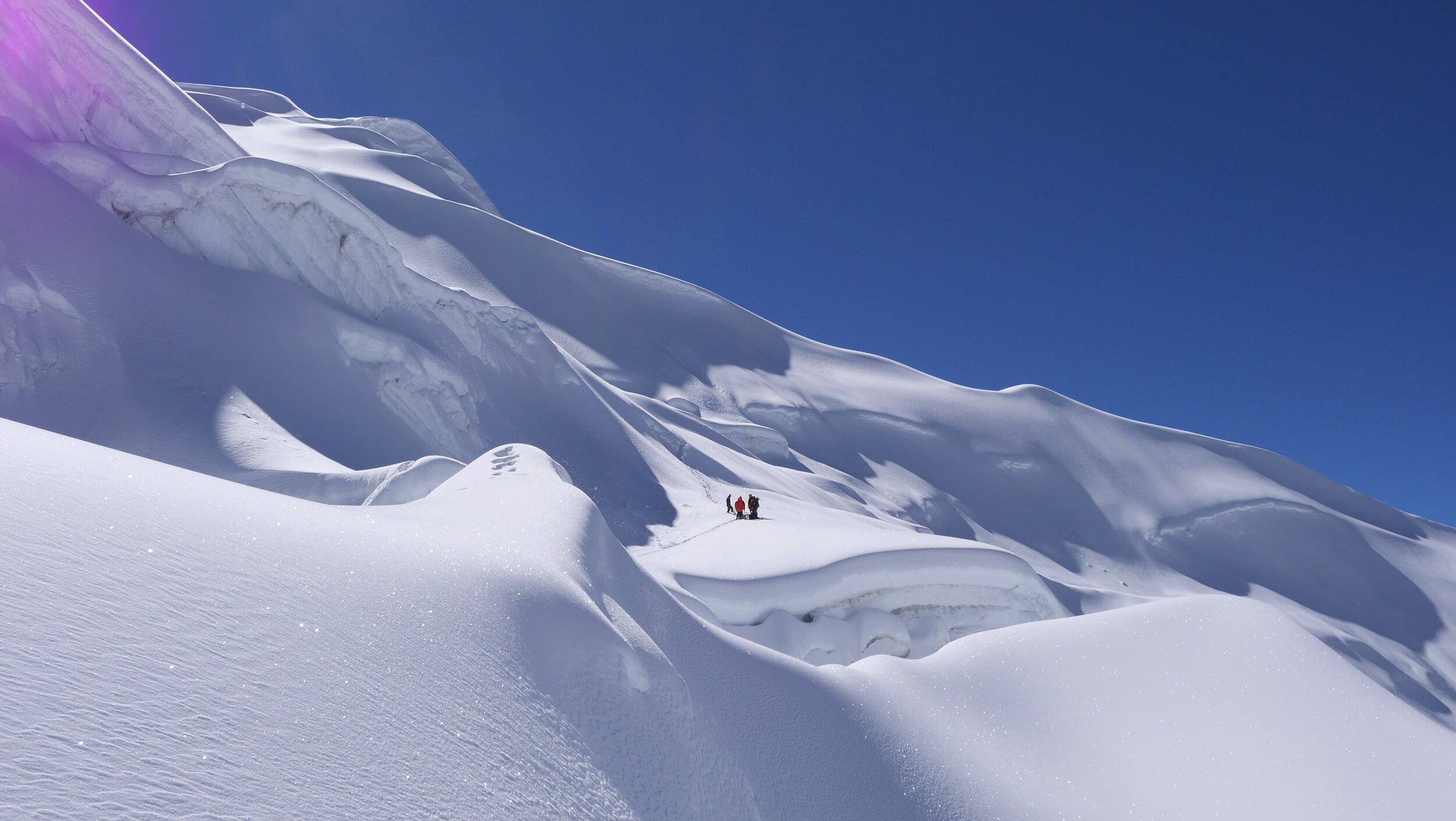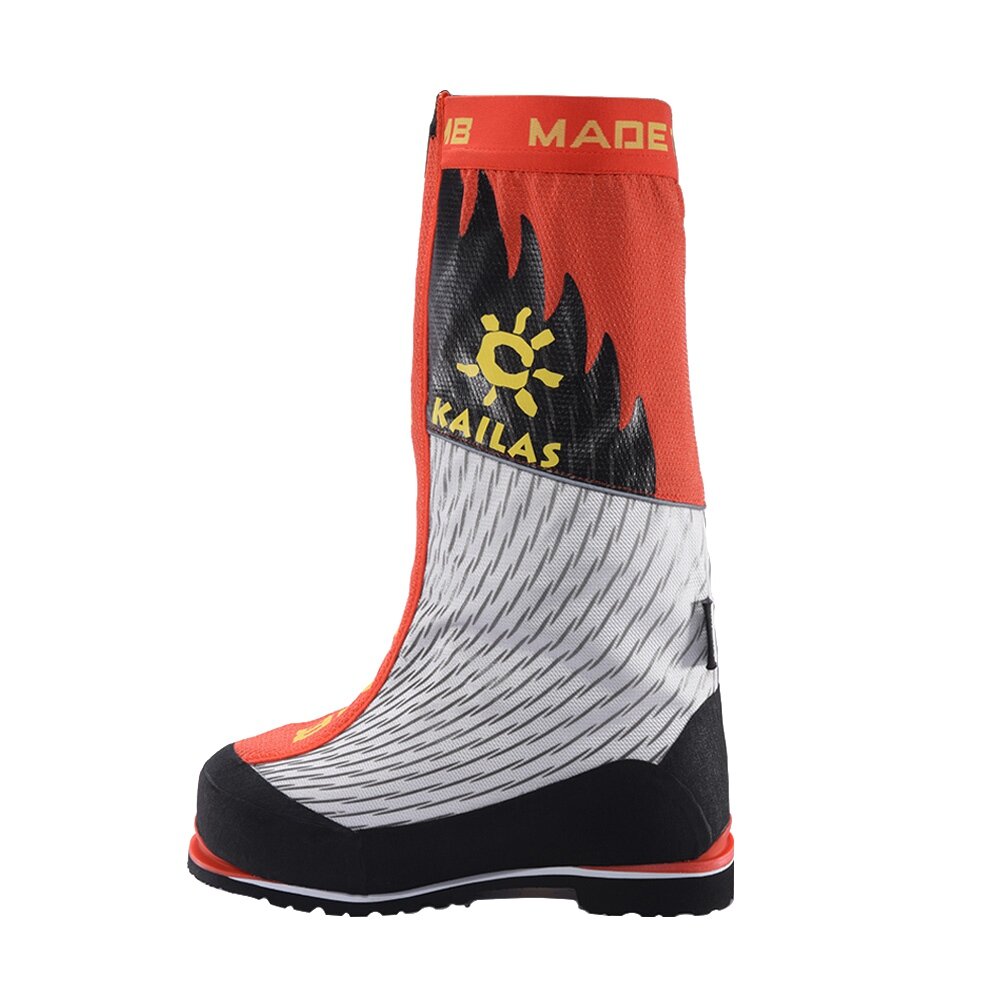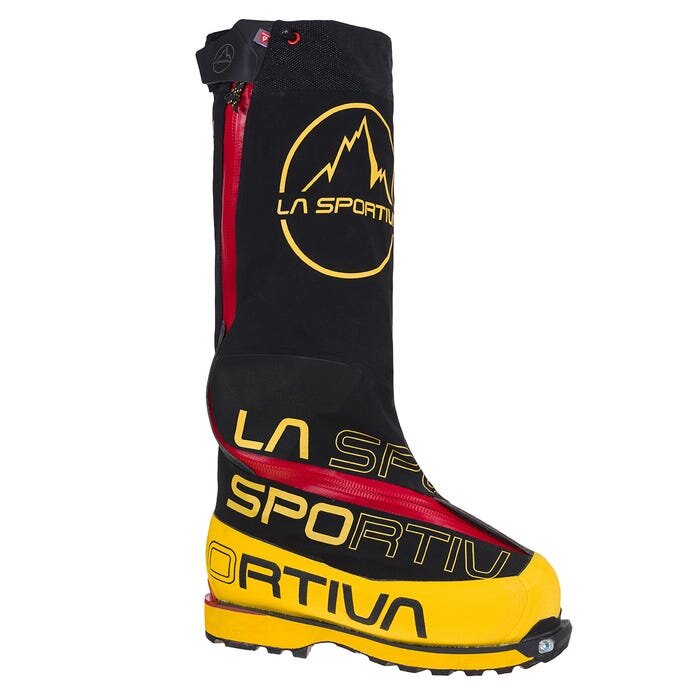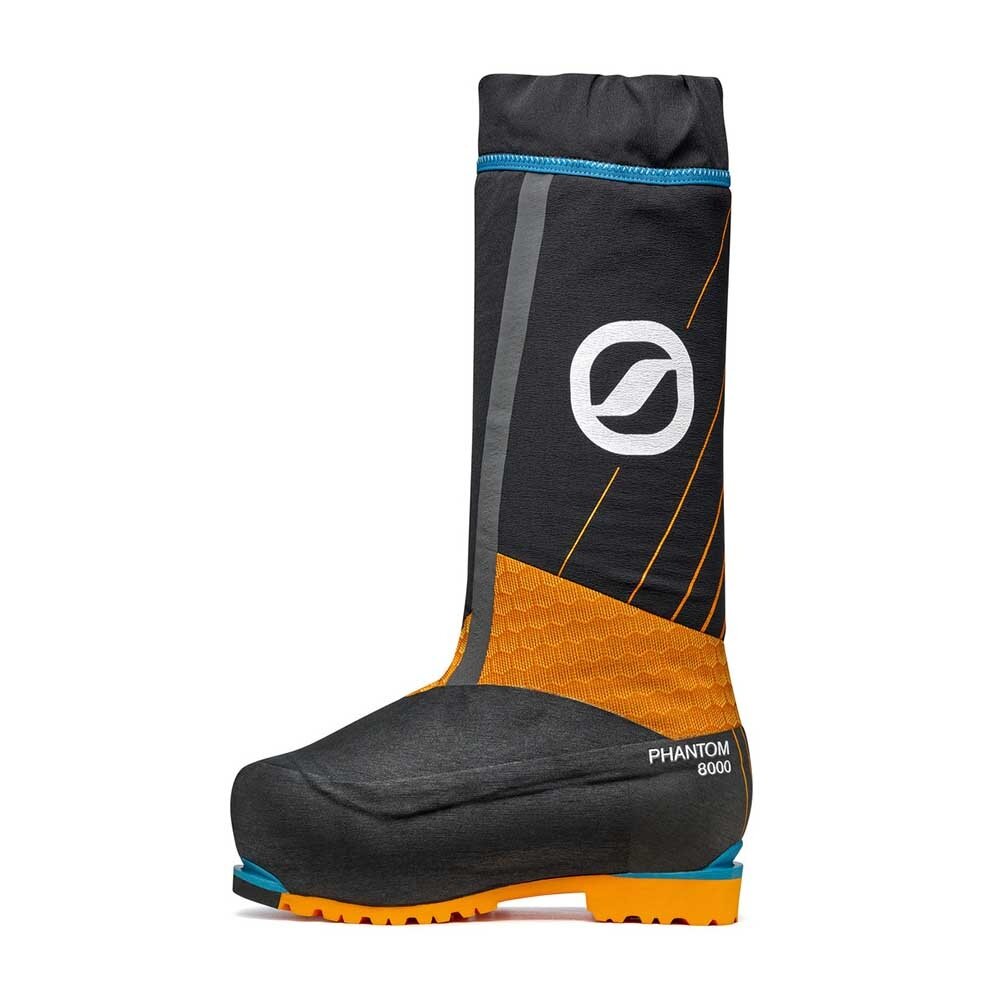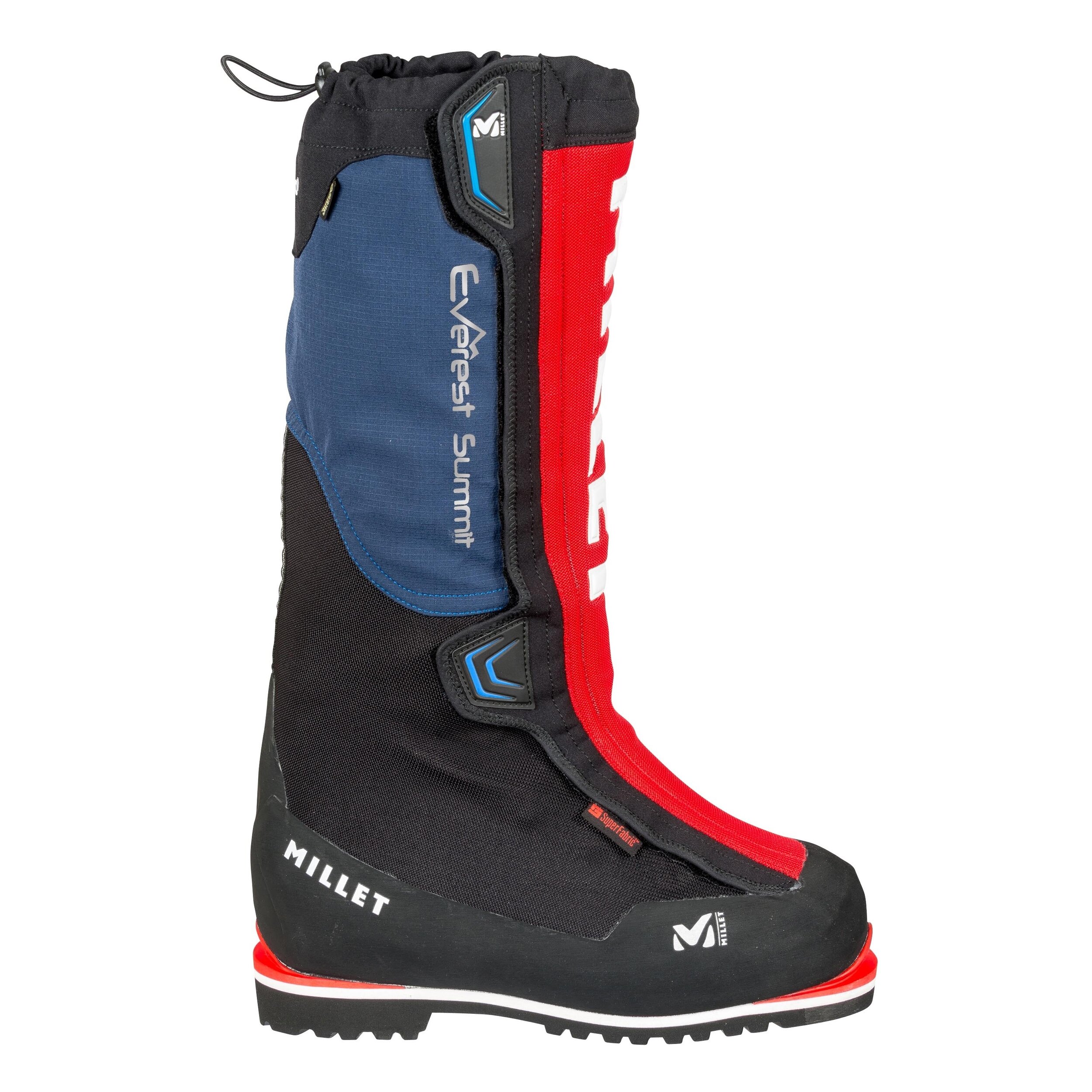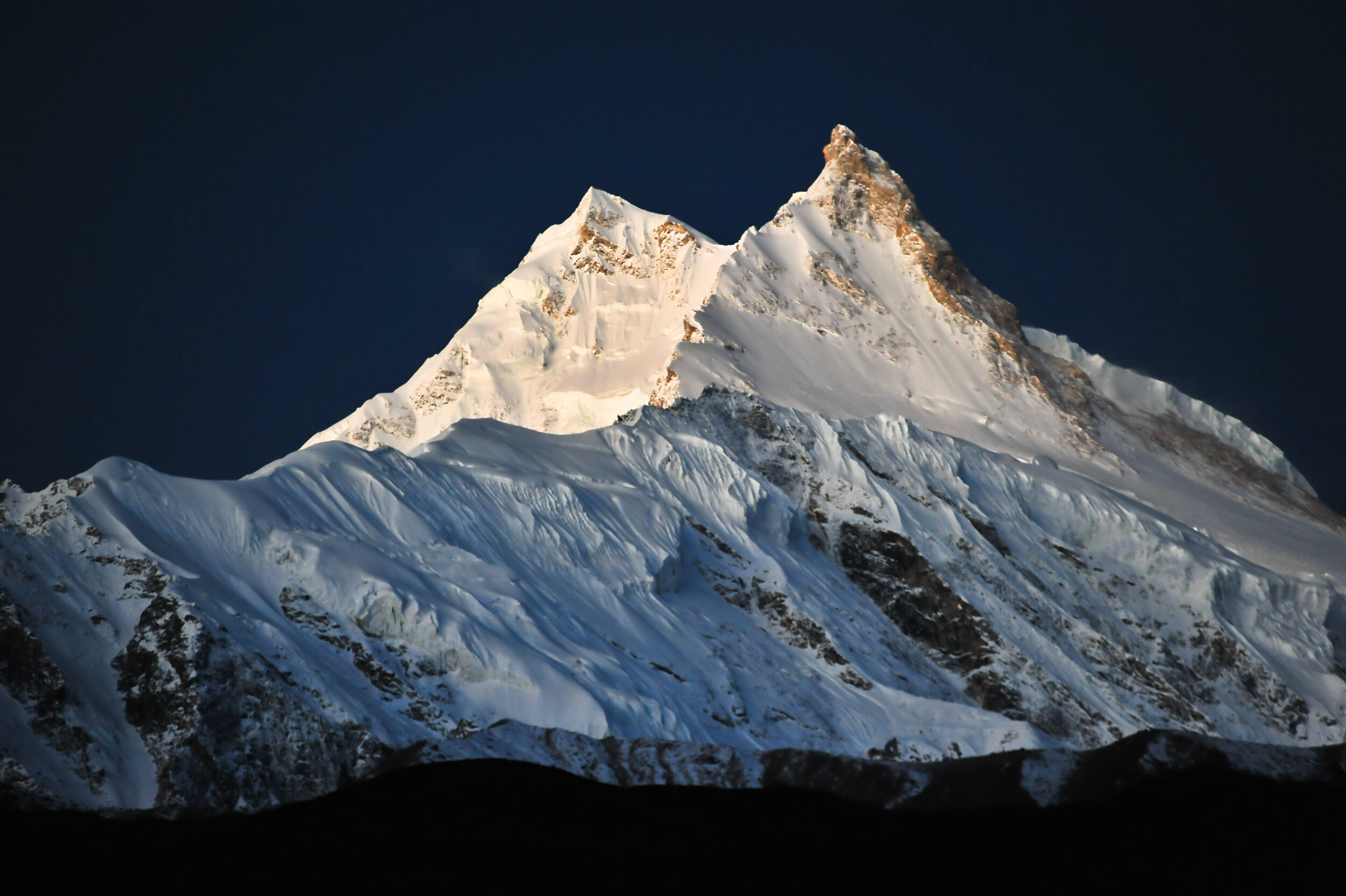Baruntse 7129M or Himlung Himal 7126M which 7000M+ mountain peak to climb? - Namas Adventure
Baruntse and Himlung Himal are perfect intermediate level and semi-technical peaks to climb at 7000M level in the Himalayas. Whatever your goals for climbing a 7000M extreme altitude expedition be, a stepping stone to an 8000er peak or climbing simply climbing a 7000er mountain peak, we highly recommend these two peak expeditions. (Putha Hiunchuli 7246M is another great option)
Both expeditions are not crowded as the 8000er expeditions (Everest/Lhotse during spring & Manaslu during autumn). Between the two expeditions, Himlung Himal has seen slightly higher climbers compared to Baruntse. (2021 Autumn, Himlung Himal 77 - 90 climbers & Baruntse 20 - 25 climbers). So, you can certain that there won’t be a crazy amount of climbers during your expedition. Having said that, it is always good to have some number of team/s in the mountain. You can never be sure when an event turns out wrong in the mountains. Every day we are playing with the forces of nature. Balance is key.
Learning from past summit data, the Himlung Himal expedition has a higher rate of summit success compared to the Baruntse peak expedition where there are several summits during the autumn season compared to 0 summits during the spring season (commercial route). Let’s look at the data from the previous 5 years of Baruntse 7129M and Himlung Himal 7126M successful summits. (commercial expeditions). Source “Himlayan Database”
Successful summits, BARUNTSE 7129M VS HIMLUNG HIMAL 7126M
So, coming to the question of which 7000M peak I should climb?
Our answer is it depends on your preference. What is it that you want from your adventure? If the summit goal is important to you (no mountain summit is 100% guaranteed) then Himlung Himal 7126M has a better odds of making it to the summit than Baruntse 7129M and is technically less challenging.
Situations change in the mountains, you never know when the next dangers pop out in the mountain, or the hazard that was there before may not even exist. Weather is a huge factor during your high camp days. You may have a clear window for the next 7+ days or it might be pouring snow and low visibility, windy for an extended period of time. Being safe and returning home safely should be your primary goal. Whatever the circumstances, you should be open to all possibilities of success or failure. What is guaranteed is a raw and thrilling Himalayan adventure in your life memoir.
With the insight data from previous years, if you would like to choose any of the 7000M expeditions mentioned above then our team at Namas Adventure is here to assist and welcome you to take on your adventure of climbing a 7000M mountain. We organize the expedition during both seasons. For yearly mountain updates and summit success, hazards in the mountains and to be part of our team on 7000M mountain expeditions or other mountaineering expeditions, please email us at - bookings@namasadventure.com. Our team will be there to assist you on your next adventure of a lifetime.
Let’s go and explore the 7000ers.
Live Your Story
Namas Adventure Team
Baruntse 7129M expedition, 2021 Mountain status updates - Namas Adventure
2021 wasn’t the year to be for any teams to successfully complete Baruntse Expedition. We had small team expeditions both during Spring and Autumn this year (2021).
Spring was a big risk with uncertainty around COVID 19. Still, we managed to get a small team of 3 members and after summiting Mera Peak, our team had settled at Baruntse Base camp 5460M and was preparing for our climb to camp 1. Soon enough our team and other teams, who have been together with us since Mera Peak learned that the person we came in contact with (a day before Mera peak climb) was evacuated to Kathmandu and tested positive for COVID. After learning this most of the teams decided to call off their expedition, since all the guide members and had been in contact with the sick person’s guiding team members, and any illness and evacuations at 6100M+ or around camp 1 and beyond would have been devastating.
Autumn, our team arrived up to camp 2 at 6400M but could not proceed further as we had a very unexpected storm and heavy snowfall (4ft - 5ft deep) for 4-5 days, our guides could not go past camp two and resorted back to base camp to wait for a clear window. After waiting out for 4 days our team went back to camp 1. Windspeeds were picking up to 60 - 70mph and a high risk of avalanche in the mountain was to follow up soon in the after 2 days. Our lead guide decided to call off the expedition since the client member did not want to add any additional days (5 - 7 days) to the expedition.
The only group or two people to summit Baruntse on (2021) spring was Marek Holecek and his climbing partner Radoslav Groh. They completed a new notorious route, climbing alpine style on the west face naming it “the heavenly trap” read more about their expedition on our blog post below ⬇️
We had previous (2019) reports that there is a huge crevasse opening when leading up to the summit but no one had a concrete certain report from 2020. Since Marek and Radoslav were the only two people to summit Baruntse in 2021 and returned via the southwest (normal expedition route) we approached him asking about any potential dangers and hazards in the mountains. Marek replied back to us with the following email. (Thank you very much Marek 🙏🏼).
Hi,
At about 6500 m there is a large transverse crack over the ridge, which at the time we were there went to overcome, but we had really a lot of snow there. The crack runs across the entire ridge. Now I don't know what it looks like. The second crack was around 6000 m, above the saddle we had to rope down. The crack at 6500 m was very dangerous.
Cheers Marek
_________________
Our expedition team could spot the hole/crack at 6000M.
We will be organizing expeditions to Baruntse during 2022 and 2023 and it is great to learn about these potential dangers and hazards beforehand. Our guiding team can expect these hazards at 6500M and prepare an additional safety line around this particular ridge section. Any teams heading to Baruntse during 2022 or 2023 can use this information for their expedition too, after all, teamwork is key during the expeditions and we would like everyone to be safe in the mountains.
Want to plan your expeditions to Baruntse Peak 7129M or other high-altitude mountaineering expeditions in the Himalayas? Please inquire about your preferred expedition to our teams as we have several 6000M, 7000M, and 8000M expeditions running in the Himalayas every year.
See you in the mountains.
Live Your Story
Visual Journey of Baruntse Expedition - Namas Adventure
The experience of climbing Baruntse is one of the most thrilling climbs in the Makalu Barun Valley. Not only is the climb beautiful and raw but it is physically challenging. Land in the buzzing historic city of Kathmandu following then to the famous Lukla airport. From there trek through the Khumbu region to enter into thick jungles of the Barun Makalu region to climb the icy summits of Mera. After acclimatizing well at Mera, the following adventure leads to the summit of Baruntse.
Climbers pass through several beautiful villages and as we reach Mera BC our alpine camping begins. Once climbers reach Baruntse base camp we rest there and prepare for our Baruntse Summit. The climb demands an intermediate level of skill and past experience and our team members are made up of highly experienced climbers. Expect a little bit of everything on the route – scrambling on the rock, climbing on steep ice/snow, and multiple camps on the mountain. Follow along as we describe the entire journey in images, as we take the beautiful yet challenging journey up to the summit of Baruntse 7129M.
Boudhanath, Kathmandu
Arrive in the vibrant and beautiful city of Kathmandu. Our team picks you up from the airport and takes you to your hotel. There you rest and can explore the cities vibrant culture and traditions. Boudhanath (Buddhist shrine) is one of the places where you can explore.
Tenzing - Hillary Airport, Lukla, Khumbu, Nepal
Expect to reach early at the airport as most Lukla flights are in the morning. Once we arrive in Lukla (40 Min flight) our expedition starts. Porters load their packs meanwhile our climbers get their breakfast and excitement begins.
Trek through the beautiful villages passing through lush jungles and rugged trails. Climbers will come across the jungles of Rhododendron and other wild trees. Also, lots of mules and Sherpa porters along the first two days of the trek.
Trek through beautiful villages and stay in local tea houses
Monasteries and other cultural sites are a perfect detours to explore.
Once you enter Makalu Valley the mountains open them selves and climbers will be walking very close surrounded all around by the Himalayas.
Climbers can expect to see a lot of high and dry granite walls and Himalayas all around when trekking to higher tea houses and camps.
As soon as we enter Makalu Barun Nation park climbers will be able to see moraines and glaciers flowing through the Himalayas. Mera-la Glacier can be seen in the far distance just below the clouds.
Climbers and porters climbing Mera - La glacier, ascending higher to Mera high camp. From Mera-la the real alpine mountaineering begins.
Mera High Camp 5460M is one of the most interesting high camps during your expedition. We camp here for a night before making our early summit push to Mera Peak summit.
Mera Summit 6476M. This is one of the most spectacular and accessible climbs for anyone with even no climbing experience before. Mera summit offers a 360 panoramic view of surrounding Himalayan peaks. Everest, Cho-Oyu, Makalu, Lhotse, Kanchenjunga, Ama Dablam, Baruntse, and other uncountable amounts of 6000M and 7000M peaks are visible on a clear summit day. A visual galore to satisfy your adventure soul.
Heading towards Seto Pokhari
After Mera Peak summit, the journey heads further deep into Hunku valley taking us through base of Chamlang and other Himalayan peaks finally arriving at Baruntse base camp 5460M.
Namas team, Baruntse base camp.
Puja ceremony at Baruntse Base camp. After a day of rest, puja is organised seeking permission from the mountain god for safe passage when climbing the mountains. A monk recites and performs the rituals meanwhile all the climbers take care in this ceremony. Spirits are high and blessings are offered and everyone is to be ready for their final part of the expedition. Mentally, physically and spiritually.
West Col to Camp 1 (6100M) is one of the challenging objectives of the expedition. Once climbers leave from base camp, it takes about 2 hours to reach the crampon point. All expedition gears are then worn and after another 45 min hike on icy surface climbers reach the base of 200M vertical wall. After 2-3 hours of jumaring climbers arrive on a flat Baruntse plateau. The lead guide then advises all the team where to set up the first camp.
Camp 2 (6400M)
Camp 2 (6400M) is a short 2 - 4 hour ascent about 400M - 500M high. Gradually going higher climbing team sets up the camp just below the Baruntse ridge.
Namas Guide Pega Sherpa can be seen descending/traversing the exposed Baruntse ridge at 7000M elevation.
Climbers leave early pushing for the Summit bid. Most of the climbing is done in the ridge section of Baruntse. This is the most challenging and dangerous section of the entire climb. After passing from three false summits finally, climbers will reach their ultimate destination. Expect a long and challenging climb.
Namas Baruntse team Pega, Nima and Chewang Sherpa successfully summited Baruntse 7129M and fixed the rope to the summit paving way for other team members.
🏔Makalu 8463M seen in the right hand side, Summit of Baruntse 7129M
Baruntse Summit 7129M. Lying just between the Great Lhotse wall and Makalu.
Fish eye view of Amphu Lhabtsa pass 5800M. Another ridge to Baruntse on the right. Everest and Lhotse in front of the climbers (between the clouds). This is the wall between Khumbu and Makalu/Huknu valley.
For more information on our Baruntse expedition or Baruntse Express expedition or any of our other international expeditions check out our website. (Call/WhatsApp) - +44 7446976060 or send us an email at bookings@namasadventure.com
When to climb Baruntse? (Spring or Autumn) - Namas Adventure
Are you wondering when the best time is to plan a Baruntse peak expedition in Nepal? Many climbers ask us this question. Based on our experience running expeditions and input from our experienced guides who regularly climb in the region, the best time for you to climb may depend on your personal preferences. Fortunately, Baruntse peak is suitable for climbing in both the spring and autumn seasons. In the following information, we will outline the conditions typically experienced during these seasons to help you decide which is the best fit for you.
Spring sees a lot more snow compared to autumn. After the winter and with ongoing spring showers, you can expect deep or fresh snow in the mountains. There appear to be more crevasse openings during the spring season. The fresh snow in the mountain definitely makes breaking the trail a lot harder (which the strong Sherpas are happy to do for you) and climbers can expect some weather-related disturbances on their planned summit window. Therefore, you should expect delays due to weather conditions. If you enjoy an extra challenge in high-altitude peak climbing, then spring expeditions might be for you. Spring definitely tests your patience, especially when things don't go according to plan and teams have to improvise a lot. That's why spring sees fewer climbers on other peaks (excluding Everest and Lhotse) compared to autumn. However, when spring does open up with a clear weather window, it is one of the best times to climb in Nepal.
Recorded Summits - There haven’t been any commercial expedition summits at Baruntse. (2005 - 2022). In 2021 Spring summit's success was recorded via a new route, alpine style by Marek Czech and Russian climbers.
Autumn is a popular time for climbers to attempt peaks in Nepal. The air is clean and crisp after the monsoon, and the snow on the Himalayan peaks has typically melted and settled compared to the deep, snowy conditions of spring. This makes climbing conditions more favorable. The autumn season begins in September and usually sees snowfall towards the end of November, with heavy falls expected as winter approaches. Baruntse also sees more teams attempting to climb during this period, although there are still fewer climbers compared to other famous expeditions like Ama Dablam or Manaslu.
Recorded Summits - Commercial expeditions have only been successful at Baruntse 7129M during the autumn season. (2006 - 2022). Namas team was able to successfully fix the ropes to the summit paving way for oncoming teams during the 2022 fall season.
Conclusion
No matter which season you prefer, climbing Baruntse and Mera is a challenging and rewarding experience. Spring offers deeper snow and more frequent showers, while autumn has less snow and stable, settled surfaces but shorter days. Both seasons offer a unique climbing experience and the opportunity to achieve a lifetime accomplishment.
Question.
Which season do you plan to climb Baruntse and Mera Peak? Please comment below, we’d love to hear from you.
We organize Baruntse with Mera peak expedition every year during autumn. Planning to climb Baruntse one day? Whatever your climbing goal is drop us an email. Our team will be glad to have you onboard and together we shall achieve the summit and enjoy the climbing experience. Our team is here to assist and make your climb in the Himalayas an enjoyable, accessible, and comfortable one.
Lets, go take on Baruntse and other peaks around the world. Go. Live Your Story.
Everything you need to know about Himlung Himal 7126M climbing Expedition - Namas Adventure
Himlung Himal, standing at 7126 meters, is a popular and relatively safe choice for climbers looking to tackle a 7000-meter peak in Nepal. Located in the rain shadow region of mid-western Nepal, this mountain offers a semi-technical climbing route with fixed ropes available to help you reach the summit. The climbing route is mostly on ice and snow, with a steep, exposed ascent to the top. Sherpa guides from different groups often work together to set up the ropes on climbing days. If you're seeking a high-altitude climbing adventure or are looking to progress to 8000M peaks or difficult challenging peaks, Himlung Himal is a must-climb.
Overview:
Altitude: 7126M / 23,379ft
Climbers experience level: Intermediate/Advanced
Location: Annapurna Region
When to climb?: Late spring Mid April - May and September - October
Total no of days: 30 Days
Difficulty grading: AD+/4 (Alpine/Fitness grading info)
Accommodation: Lodges and Base camp, Camp 1/2/ 3(Optional)
We have listed 10 useful pieces of information that will help you prepare for your Himlung Himal peak climbing expedition.
1. When is the best time to climb Himlung Himal?
Himlung Himal is best suited to climb during the mid-spring season around mid-April to May or during the early autumn season; just towards the end of the monsoon season. End of August to the end of October.
Note - Himlung is one of the remote climbing peaks with very few teams attempting the climb every year. You can be certain there won’t be many climbers or traffic during your expedition.
2. How much does the Himlung Himal expedition cost? What does it include?
Join the Namas Adventure team for a Himlung Himal expedition at a cost of $9050 per person. Our all-inclusive peak climbing services are of the highest quality and prioritize your safety with a 1:1 guide-client ratio, several successful summits, 100% safety records, and cultural immersion. As a responsible, ethical, and sustainable mountain adventure brand, we are committed to our core values and ensuring that you can fully enjoy your climbing holiday without worrying about any logistics. With our team by your side, you can focus on the fun and adventure ahead.
List of what’s included in your booking.
IFMGA/NMA certified Guide leader
$500 Individual tip pool. Tip pool will be fairly distributed among all Namas staff members. (Guides, porters, drivers, hotel security, and staff). Guest may personally hand in extra tips to our guides and porters)
Namas Branded merchandise (Down Jacket, Cap, Buff)
1:1 Sherpa Guide /client ratio
Head chef and 2 kitchen helpers (Assistants increase with the number of climbing team members )
Arrival hotel in Kathmandu
All trekking and climbing permits (Annapurna Region Permit and TIMS)
All internal-local transportation to and from the trekking trailhead
Expedition tents (2 or 1-person tents ) Brands Salewa, Mountain Hardwear, Samaya equipment, Kailas
40 kgs personal weight
Freezed dried or meals during camping days (Chicken, mushroom, vegan options, etc)
Chocolate, biscuits, canned foods, nuts
Burners and expedition equipment
Walkie-talkie/ Satellite phone
Breakfast, Lunch, and Dinner on trek and expedition days.
Lodge accommodation during the trek
Porters per guest
Arrival pick up and departure
Internal flights
Basic First aid kit
Welcome/Farewell leave Dinner
3. What experience do climbers need to climb Himlung Himal? Are guides necessary for Himlung Himal climb?
Experiences - It is essential for climbers to have previous high-altitude alpine/mountaineering experience (at or above 3000 meters) in order to successfully climb Himlung or other 7000-meter peaks. While this experience does not necessarily need to be in Nepal, it is important for climbers to be comfortable using crampons on snow, ice, and steep surfaces, proficient in using fixed ropes to climb steep and exposed sections, and familiar with the use of climbing gear and basic rope techniques such as tying safety knots and abseiling. Mental toughness and the ability to withstand cold and windy conditions are also crucial for climbers attempting Himlung or other major expeditions in Nepal. The use of jumars and rappelling/abseiling skills will be necessary for descending the mountain, and it is important for climbers to have the strength and endurance to sustain these activities for an extended period of time.
Local Guides - According to Nepalese law, all climbers attempting peaks above 6000 meters must be accompanied by a guide. To obtain a permit for climbing Himlung Himal, it is necessary to go through a registered local company. For intermediate-level climbers, we strongly recommend hiring a guide for this peak due to the presence of crevasses and other potential hazards along the usual climbing route. However, if you are an experienced climber with many successful climbs under your belt, you may wish to explore less traveled routes. In this case, it is still a good idea to have a guide as a backup in case of unexpected challenges.
4. What is the best-acclimated itinerary for climbing Himlung Himal Expedition?
Proper acclimatization is crucial for the success and safety of high-altitude climbing trips. It allows the body to rest, adapt, and become stronger, enabling you to reach even higher elevations. At Namas Adventure, we take a slow and steady approach to high-altitude climbing, with itineraries that have been carefully crafted through our years of experience. This ensures that you are well-prepared and able to fully enjoy your adventure.
On the Himlung Himal expedition, we have established 2-3 high-altitude camps to allow climbers sufficient time to acclimatize. This helps to ensure that you are properly adapted to the high altitude and able to successfully reach the summit. Our experienced guides will help you to monitor your progress and provide guidance and support throughout the trip to help you reach your goals.
More details are on our Himlung Himal climbing strategy.
5. What training is required for Himlung Himal? Can you suggest to me a training plan?
Himlung Himal is a great mountain for anyone looking to tackle their first 7000-meter peak or a semi-technical, high-altitude expedition. It is known to be one of the easier and safer 7000-meter mountains, with a high success rate. However, it is important to note that no mountain peak is easy to climb and we do require interested climbers to have previous high-altitude experience (at or above 3000 meters) in order to participate. If you are seeking a challenging yet achievable climbing adventure, Himlung Himal may be the perfect mountain for you.
Mountains are graded based on their technical and physical difficulties. It can be difficult to simulate the specific challenges you will face on the mountain, such as crossing crevasses, in your training. However, there are some general fitness activities that can help you to build endurance, strength, and core stability. These may include long-distance running (10K - 20K), long-distance hiking (6 hours+), cycling, and hiking with a weighted backpack. We recommend scheduling your training at least 5-6 months before your climbing departure to ensure that you are in peak physical condition. More on our training mountain expedition blog.
Courses like beginner mountaineering classes are also a helpful tool. You will learn technical skills like climbing with a rope on 5/6 anchor points using ascenders, how to walk with crampons on ice, snow, and rock, and to be efficient with abseiling and overall gear safety checks awareness.
6. How hard is Himlung Himal climbing expedition?
Himlung Himal is graded at PD+ - AD/4 in difficulty. (Alpine/Fitness grading link).
It is imperative that climbers are in top physical condition before embarking on the Himlung Himal expedition. The climb will be physically and mentally demanding, with a total of 15 days of alpine climbing. Proper acclimatization, hydration, and nutrition are key to coping with the altitude and breathing challenges. The real alpine challenge begins when we depart from the base camp, also known as the French base camp, and encounter glaciers and ice surfaces on the climb. The route to the summit involves traversing some uphill, slippery sections, as well as traversing some crevasses. The campsites are located in wider sections of the mountain, reducing the risk of setting up camp on exposed cliffs. Fresh snow is also a possibility along the route. Proper training in endurance and strength should have prepared your body to handle these challenges.
7. What are the clothing and gears - boots required for Himlung Himal climb (trekking and mountaineering)? Can I rent gears for Himlung Himal climb?
The right gear is essential for a successful and comfortable climb. We recommend that climbers invest in high-quality gear and clothing, and pay attention to layering in order to stay warm in the cold temperatures that can drop as low as -10C/-20C at night. It is important not to skimp on quality, as you will be relying on your gear to keep you warm and comfortable during the climb. Please check our equipment blog for recommended clothing and gear.
Is it a good idea to rent climbing gear in Nepal? In our experience, we do not recommend it. We have tried various gear rentals in Nepal and have not been satisfied with the quality. While it may seem expensive to purchase all the necessary gear, it is worth the investment in the long run. You can also consider renting gear from reputable adventure gear companies in your own city. Gears of well-known adventure brands such as North Face, Mountain Hardware, or Kailas are recommended. Make sure to choose original products from trusted brands to ensure the best performance and safety on your climb.
Boots (trekking and mountaineering) for Himlung Himal
With better technologies, climbing shoes have improved every year. We highly recommend double-layered boots like Kailas Everest 8000M, La Sportiva Olympus Mons Cube, Scarpa 8000 phantom, Millet Everest summit GTX. It is wise to spend on good mountaineering boots, as so with all the gears that we have mentioned in this post above.
More 8000M boots link here (other media article)
8. What types of foods are available during Himlung Himal climb? Is clean water available and how much water intake is recommended? Hydration and nutrition
To ensure proper hydration, we recommend that all clients drink 4-6 liters of water per day. It is helpful to bring hydration tablets or filtration bottles. Obtaining water at higher camps can be difficult, so our team will do their best to boil snow and provide water at higher camps and during the summit push. Most meals are prepared in tea houses, and during climbing days, our Sherpa team sets up kitchen tents at the base camp. Sherpa guide members will cook quick meals at higher camps. While it can be difficult to eat enough in cold, high altitudes, it is important to try to force yourself to eat. We also provide packed dried meals as an alternative option.
It is important to avoid smoking and alcohol consumption during the Ama Dablam expedition. While it may be common to see the guiding leaders engage in these activities, they are professionals who have adapted well to high-altitude environments. As a climber on this adventure holiday, it is important to prioritize your health and well-being by abstaining from these harmful habits. Remember to also pay attention to your diet and hydration, as these will greatly affect your performance on the mountain.
9. What trip insurance will I need for Himlung Himal climb? Do I need helicopter evacuation to be included in my insurance coverage?
No matter how prepared you are, you never know when or how things might go wrong. You might be sick suddenly or not that we wish but there might be some incident, you might suffer from altitude sickness or anything we can’t imagine yet. So, for these reasons, it is always good to have insurance cover. Our recommended Insurance companies (link)
Helicopter evacuation is our final emergency option and we do recommend you have one in your insurance, as it is the only means of transport in the Everest region. Our guides will assess your condition and examine if it is a major issue. If not, they will use their experience to motivate and push you through your trip. However, in case of emergency, helicopter evacuation will be called upon.
There is a procedure to follow when calling for emergency evacuation. We will call the insurance company hotline, get approval from your insurance, and only then helicopters are sent to the distress call location. You will have to pay for the evacuation in Nepal from your own pocket but once you are back home you can claim your money back. Make sure you collect helicopter evacuation receipts and a certified doctor’s approval letter. The insurance company will ask for this evidence to back up your claim. There was a huge helicopter scam in Nepal in 2018, so insurance companies are taking extra measures to stop this from happening. Our guides and staff members in Kathmandu will also remind you of this process during briefings.
10. Next climbing goals after Himlung Himal climbing
After completing your Himlung Himal climb we would like to recommend the following challenging expeditions
1. Ama Dablam 6819M and Island Peak 6189M climbing expedition - Click here
Technically difficult and climbing goal for many mountaineers. Ama Dablam is well renowned as one of the most beautiful and exposed Himalayan mountain in the Everest region. It is one of the most sought mountains to climb by mountaineering enthusiasts. Whether you plan to do it before or after your bigger expedition like Everest, Ama Dablam climb in itself is a mountaineering challenge on its own. Ama Dablam is considered "a must-do" for alpinist and mountaineers.
2. Manaslu 8163M Expedition - Click here
Want to experience 8000M+ a death zone altitude and gain the right experience for Everest or other higher extreme altitude climb? Manaslu Expedition is for any aspiring mountaineers who are considering climbing an 8,000m peak or higher. Manaslu has to be one of the preferred options if you are looking to climb the 8000M peaks and is also a necessary option to get that 8000M experience before attempting to climb Mount Everest. The expedition begins with trek to Manaslu trails passing through the village at the foot of the mountain where then arrive at Manaslu Base Camp to begin the climb.
3. Mt. Everest 8848M Expedition, Nepal
Himlung Himal climbing expedition is one of the remote trek and climbing destinations in Nepal. As we will be able to many more expeditions down the year we believe Himlung Himal Expedition can be one of the classic mountaineering adventures at 7000M level that will be accessible and climbable for upcoming climbers. The charm of its remote location tucked away in the not-so-popular area of Nepal, beautiful trek through the Annapurna valley and nomad culture makes the whole trip experience an amazing adventure. We hope the information we have provided above will help you decide/prepare in the best way before you embark on your Himlung climbing expedition. If you are looking for a great climbing trip and have an amazing time in Nepal then we would love to have you on board for our Himlung Himal expedition. You can be assured that you are provided quality services with our fun-loving yet professional guides who have 5 - 10+ years of taking clients on such peak climbing trips. After all, we do aim to be the best adventure specialist in the world and you having a great time, being safe and summiting will always be our priority.
If you do have any more questions, please ask us below in the comment section or you can email us at bookings@namasadventure.com and our team will get back to you as soon as they can. Stay well. Challenge yourself. Dare great things and live your story.
Climb - Himlung Himal 7126M Expedition
Everything you need to know about Baruntse Peak climbing Expedition - Namas Adventure
Baruntse Peak 7129M is one of the accessible 7000M+ climbing peaks in Nepal. Sitting just between the world’s highest peak Mt.Everest and Makalu, this expedition will give you a glimpse and scale of the surrounding 8000M+ mountain peaks. Most climbing is done via the southeast ridge, semi-technical in technicality where the guiding team will have fixed the rope all the way to the summit. During climbing days, local Sherpa guides leaders from several teams colloborate together to set up the ropes. The climbing route is mostly on ice and snowy surfaces with an exposed section past 6600M+ all the way to the summit. This is definitely a must climb for any climbers seeking high-altitude climbing adventure or progress to 8000M+.
We have listed 10 useful pieces of information that will help you prepare for your Baruntse peak climbing expedition.
1. When is the best time to climb Baruntse Peak?
Baruntse Peak is best suited to climb during two climbing seasons. Autumn (September - November).
Note - Mount Baruntse is one of the remote climbing peaks with very few teams attempting the climb every year. You can be certain there won’t be many climbers or traffic during your expedition.
2. How much does the Baruntse Peak expedition cost? What does it include?
Please visit our Baruntse page for the updated yearly costs [link]. With a 1:1 guide-client ratio, our team is dedicated to ensuring your safety, successful summit, enriching cultural experiences, and overall enjoyment of the trip. As a company, we uphold our core values of responsibility, ethics, and sustainability in all our mountain adventure activities. With us, climbers can be confident that every detail is handled, allowing them to fully immerse themselves in their climbing holiday and the enjoyable experiences that await.
List of what’s included in your booking.
IFMGA or NNMGA certified Guide leader
Namas Branded merchandise (Down Jacket, Cap, Buff)
1:1 Sherpa/client ratio
Helicopter flight back to Lukla from Baruntse BC after returning to BC
Head chef and 2 kitchen helpers ( Helpers increase with the numbers in climbing team members )
Arrival hotel in Kathmandu
All trekking and climbing permits (Khumbu Region Permit and TIMS)
All internal-local transportation to and from the trekking trailhead
Expedition tents (2 or 1 person tents) Brands Salewa, Mountain Hardwear, Samaya equipment, Kailas
30 kgs personal weight
Freezed dried meals during camping days (Chicken, mushroom, vegan options etc)
Chocolate, energy bars, hydration pills, biscuits, canned foods, nuts
Burners and expedition equipment
Walkie talkie/ Satellite phone and GPS
Breakfast, Lunch, and Dinner on trek and expedition days.
Lodge accommodation during the trek
Porters per guest
Arrival pick up and departure
Internal flights
Basic First aid kit
Welcome/Farewell leave Dinner
3. What experience do climbers need to climb Baruntse? Are guides necessary for Baruntse Peak?
Experiences - Previous high altitude (3000M - 6000M+) alpine/mountaineering climbing experiences are absolutely necessary in order to climb Mount Baruntse or other 7000M+ peaks. It necessarily doesn’t have to be in Nepal but can be anywhere else in the world. Climbers need to have good knowledge and experience in hiking/climbing using crampons on snow, ice, and steep surfaces. Must be comfortable and proficient in using a fixed rope to climb on steep and exposed sections. Climbers should be familiar with the use of climbing gears, and basic rope techniques like tying safety knots, and abseiling when coming down from the mountains, and have the mental toughness to climb in cold and windy conditions.
Local Guides - By Nepalese law, when issuing permits for high altitude peaks above 6000M+ guides are a must. To issue a permit for Baruntse Peak climbing it will have to go through a registered local company. For intermediate experience level climbers, we highly suggest climbing the peak with guides. The usual climbing route does have a crevasse and there can be other danger points along the unexplored routes. However, if you are one of the experienced climbers with tons of climbing routes under your belt then there can be several routes that even local guides may not be able to climb. So even if you climbers want to explore new routes then taking a guide as a backup option would be a wise choice.
4. What is the best-acclimated itinerary for climbing Baruntse?
Amphu Lhbatsa Pass 5840M (Namas Adventure)
Climbing up Amphu Lapcha pass will get our members warmed up with Jumaring and scramble/traverse the rocky section of the mountain. Gaining an altitude of 5840M will help climbers further acclimatize before we set off to Baruntse BC 5400M.
Mera Peak climbing (6,476 M) is another alternative to acclimatize and before we head onto Baruntse. The route itself is a very non-technical, steep climb on the ice and snowy surface. Mera mountain is classed as a trekking and climbing peak.
Over the years, we have learned to avoid using Mera Peak as our acclimatization peak because our climbers often become fatigued from the climb. This fatigue has led to difficulty in recovering fully, which affects their performance on the subsequent Baruntse expedition.
5. What training is required for Baruntse Peak? Can you suggest to me a training plan?
Baruntse 7129M expedition, is by no means an easy climb and we require interested climbers to have a previous high altitude of at least (4000M - 6000M) climbing anywhere in the world. Mountains are graded based on their technical and physical difficulties. For your training, it is very hard to mimic walking on ladders like the ones you will come across when crossing the crevasse. We highly recommend focusing on endurance, core, and strength training. Any type of aerobic exercise, like long-distance running (10-20km) 3 to 4 times a week, cycling (1 hour - 2 hours), hiking gaining elevation with 15-20kgs weights are some of the suggested training. We also advise clients to mix strength and muscle endurance training when climbing this peak. Kettlebell routines or cross-fit training are recommended. We advise you to schedule your training at least 5-6 months before your climbing departure. More on our training mountain expedition blog.
Courses like beginner mountaineering classes are also a helpful tool. You will learn technical skills like climbing with a rope on 5/6 anchor points using ascenders, how to walk with crampons on ice, snow, and rock, and to be efficient with abseiling and overall gear safety checks awareness.
6. How hard is Baruntse Peak climbing expedition?
Baruntse expedition is graded at AD+ \ 4 in difficulty. (Alpine / Fitness grading link).
We cannot stress it enough, but it is very important climbers are mountain fit and strong before starting the expedition. In total, we will have 15 days of alpine climbing days and the climb will demand every ounce of your fitness and awareness. Breathing is challenging but with proper acclimatization done ahead of time and by staying well-hydrated and consuming enough nutrition, you should be able to cope with the altitude.
7. What are the clothing and gears - boots required for Baruntse Peak climb (trekking and mountaineering)? Can I rent gears for Baruntse Peak climb?
Choosing the right gear is very important. We advise climbers not to make compromises on the quality of gears and clothing, and to pay attention to layer up comfortably as well. You will depend highly on your clothes to keep you warm enough for the dropping temperatures at nighttime which can go down to -10c /-20c. Please check our equipment blog for recommended clothing and gear.
Renting your gear in Nepal? You can hire these gear from our team in Nepal. (link)
Boots (trekking and mountaineering) for Baruntse Peak
With better technologies, climbing shoes have improved every year. We highly recommend double-layered boots like Kailas Everest 8000M, La Sportiva Olympus Mons Cube, Scarpa 8000 phantom, Millet Everest summit GTX. It is wise to spend on good mountaineering boots, as so with all the gears that we have mentioned in this post above.
More 8000M boots link here (other media article)
8. What types of foods are available during Baruntse Peak climb? Is clean water available and how much water intake is recommended? Hydration and nutrition
We suggest all our clients to drink 4-6 l of water every day. Staying hydrated will also help you with acclimatizing properly. It’s best to take hydration tablets or filtration bottles with you.
Most of the foods are prepared in the tea houses and during your climbing days, kitchen tents are set up by our Sherpa teams. You do not need to worry about food but remember to eat enough. In high altitudes, although the weather is extremely cold, your body will naturally want to reject food or avoid using energy on anything, which includes eating too. You might have to force yourself with the first couple of bites and then eventually your body will start accepting the food. We also provide packed dried meals, so that clients have other options should they not want to eat what’s being cooked in the tents.
Remember to avoid smoking and any alcohol intake. You might see our guiding leaders smoking or drinking but remember they are professionals and they have adapted very well to these environments compared to the climbers who go there just for adventure holidays.
9. What trip insurance will I need for Baruntse Peak climb? Do I need helicopter evacuation to be included in my insurance coverage?
No matter how prepared you are, you never know when or how things might go wrong. You might be sick suddenly or not that we wish but there might be some incident, you might suffer from altitude sickness or anything we can’t imagine yet. So, for these reasons, it is always good to have insurance coverage. Our recommended Insurance companies (link)
Helicopter evacuation is our final emergency option and we do recommend you have one in your insurance, as it is the only means of transport in the Everest region. Our guides will assess your condition and examine if it is a major issue. If not, they will use their experience to motivate and push you through your trip. However, in case of emergency, helicopter evacuation will be called upon.
There is a procedure to follow when calling for emergency evacuation. We will call the insurance company hotline, get approval from your insurance, and only then helicopters are sent to the distress call location. You will have to pay for the evacuation in Nepal from your own pocket but once you are back home you can claim your money back. Make sure you collect helicopter evacuation receipts, a certified doctor’s approval letter. The insurance company will ask for this evidence to back up your claim. There was a huge helicopter scam in Nepal in 2018, so insurance companies are taking extra measures to stop this from happening. Our guides and staff members in Kathmandu will also remind you of this process during briefings.
10. Next climbing goals after Baruntse peak climbing
We can make following recommendations
1. Ama Dablam 6819M and Island Peak 6189M climbing expedition - Click here
Technically difficult and climbing goal for many mountaineers. Ama Dablam is well renowned as one of the most beautiful and exposed Himalayan mountain in the Everest region. It is one of the most sought mountains to climb by mountaineering enthusiasts. Whether you plan to do it before or after your bigger expedition like Everest, Ama Dablam climb in itself is a mountaineering challenge on its own. Ama Dablam is considered "a must-do" for alpinist and mountaineers.
2. Manaslu 8163M Expedition - Click here
Want to experience 8000M+ a death zone altitude and gain the right experience for Everest or other higher extreme altitude climb? Manaslu Expedition is for any aspiring mountaineers who are considering climbing an 8,000m peak or higher. Manaslu has to be one of the preferred options if you are looking to climb the 8000M peaks and is also a necessary option to get that 8000M experience before attempting to climb Mount Everest. The expedition begins with trek to Manaslu trails passing through the village at the foot of the mountain where then arrive at Manaslu Base Camp to begin the climb.
3. Annapurna IV 7525M, Nepal
Baruntse Peak climbing expedition is one of the exciting mountain climbing expeditions in Nepal. We hope the information we have provided above will help you decide/prepare in the best way before you embark on your Baruntse Peak climbing expedition. If you are looking for a great climbing trip and have an amazing time in Nepal then we would love to have you on board for our Baruntse Peak Peak climbing trip. You can be assured that you are provided quality services with our fun-loving yet professional guides who have 5 - 10+ years of taking clients on such peak climbing trips. After all, we do aim to be the best adventure specialist in the world and you having a great time, being safe and summiting will always be our priority.
Climb - Baruntse 7129M with Mera Peak 6476M link
If you do have any more questions, please ask us below in the comment section or you can email us at bookings@namasadventure.com and our team will get back to you as soon as they can. Stay well.
Challenge yourself. Dare great things and live your story.






































